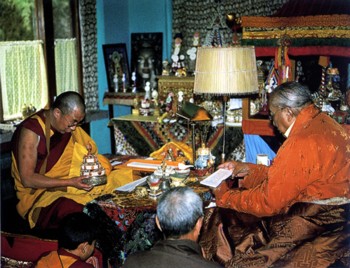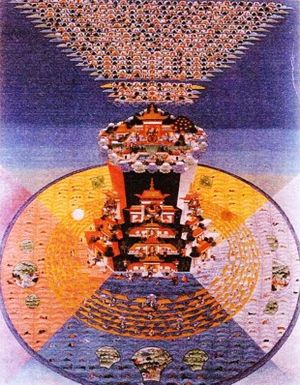Mandala offering

Mandala offering (Tib. མཎྡལ་འབུལ་བ་, mandal bulwa, Wyl. maṇḍal 'bul ba) — a preliminary practice for accumulating merit, in which one symbolically offers the entire universe to the field of merit.
Essence
In essence, mandala offering is described as offering the universe. As it says in a tantra:
- Through offering to all the buddhas in their pure realms
- The entire billionfold universe,
- Adorned with all kinds of desirable gifts,
- The wisdom of buddhahood is perfected.[1]
Etymology
The word maṇḍala can be broken into two parts: maṇḍa means the 'essence' or 'centre and circumference' and la means 'taking hold of'. Therefore we can say that mandala means to take hold of the basis or essence for accomplishing all the glorious qualities of the higher realms and the kingdom of Dharma, the sacred truths of cessation and the path. [2]
Subdivisions
Trikaya Mandala Offering

In the Longchen Nyingtik Ngöndro practice, the mandala offering is known as the trikaya mandala offering. As Yukhok Chatralwa Chöying Rangdrol explains:
- ...the ordinary nirmanakaya mandala consists of one hundred times ten million worlds each of which has four continents, Mount Meru, and the realms of the gods. This great buddha field is filled with all the abundant riches of gods and men, including the seven precious emblems of royalty and so on. Offer especially your own body, possessions and virtues, in their entirety and without hesitation. And think to yourself: "May I obtain nirmanakaya sovereignty, and, through turning the wheel of Dharma, lead beings along the path to liberation and omniscience."
- Then for the extraordinary sambhogakaya mandala, in the space above, consider that the piles represent the five buddha families, complete with the five certainties, in the blissful paradise of Akanishtha-Ghanavyuha, where countless goddesses, such as the goddess of beauty and the rest, offer vast unimaginable clouds of offerings to stimulate the senses. Think: "Through this vast and boundless offering, may we experience the sambhogakaya realms!"
- In the sphere above is the special dharmakaya mandala. The naturally arising wisdom of the way things are has always been present as mind's very nature as the 'youthful vase body'. Upon the ground of this youthful vase body, the utter purity of all that appears and exists, arrange piles to represent the appearances of pure realms, deities and palaces, purified entirely of any clinging to kayas and tiklés, and arising as ornaments of the display of reality itself, unceasing compassionate energy and the manifestation of clear light. Think: "Through this offering, may we enjoy the realm of the dharmakaya Samantabhadra!"[3]
Other Forms of Mandala Offering
- The 'Thirty-seven Point Mandala Offering' composed by Chögyal Pakpa, the Sakyapa Protector of Beings, is well known.
- The master Buddhaguhya taught a thirteen point mandala offering according to the tradition of yoga tantra, which consists of Mount Meru, the four continents and the [eight] subcontinents, but without the sun and moon.
- The master Jetari described a seventeen point offering, in which the sun and moon, and the parasol and victory banner are added to the four continents, eight subcontinents and Mount Meru.
- The master Manjushrikirti spoke of a twenty-three point offering, in which the seven emblems of royalty, the vase of treasure and the sun and moon are offered in addition to Mount Meru and the continents and subcontinents.
- The tradition of the Kalachakra Tantra includes a twenty-five point mandala which, in addition to these twenty-three, features [the planets] Rahu and Ketu.[4]
Benefits
As for the benefits of mandala offering, it is said that it will help to perfect entirely the six transcendent perfections, which are the foundation or support for all the qualities of the paths and bhumis. The Mandala Sutra says:
- Offering the mandala, together with bajung, is generosity.
- Cleaning it thoroughly is discipline.
- Removing any tiny forms of life is patience.
- Practising with enthusiasm is diligence.
- Meditation is focusing the mind in that moment.
- Wisdom is properly drawing the mandala design.[5]
Notes
- ↑ Lobpön Thekchok Yeshe Dorje, རྫོགས་པ་ཆེན་པོ་ཀློང་ཆེན་སྙིང་ཐིག་གི་སྔོན་འགྲོའི་རྣམ་བཤད་མཚུངས་མེད་བླ་མའི་བྱིན་རླབས་ཆར་རྒྱུན་, rdzogs pa chen po klong chen snying thig gi sngon 'gro'i rnam bshad mtshungs med bla ma'i byin rlabs char rgyun, pp.101-2
- ↑ ibid, p.102
- ↑
 Mandala Offering, by Yukhok Chatralwa Chöying Rangdrol
Mandala Offering, by Yukhok Chatralwa Chöying Rangdrol
- ↑
 Mandala Offering, by Yukhok Chatralwa Chöying Rangdrol
Mandala Offering, by Yukhok Chatralwa Chöying Rangdrol
- ↑ ibid, p.103. Also quoted in Jamyang Khyentse Chökyi Lodrö's Yeshe Saldrön
Oral Teachings Given to the Rigpa Sangha
- Yangsi Kalu Rinpoche, Lerab Ling, 14 April 2010, am
Further Reading
- Offering the Mandala: A Guide to the Practice of Mandala Offering, Rigpa Publications, 2009.
- Khenpo Ngawang Pelzang, A Guide to the Words of My Perfect Teacher (Boston & London: Shambhala, 2004), Part Two, Chapter Four: 'Offering the Mandala to Accumulate Merit and Wisdom'.
- Padmasambhava & Jamgön Kongtrul, The Light of Wisdom, Vol. Two, translated by Erik Pema Kunsang (Boudhanath: Rangjung Yeshe Publications, 1986-98), pages 73-76.
- Patrul Rinpoche, The Words of My Perfect Teacher (Boston: Shambhala, Revised edition, 1998), Part Two, Chapter Four: 'Offering the Mandala to Accumulate Merit and Wisdom'.
Internal Links
- Thirty-Seven Point Mandala Offering
- Trikaya Mandala Offering from the Longchen Nyingtik Ngöndro
- Short mandala offering
- More Mandala Offering Prayers
- Mandala Offering Mantras